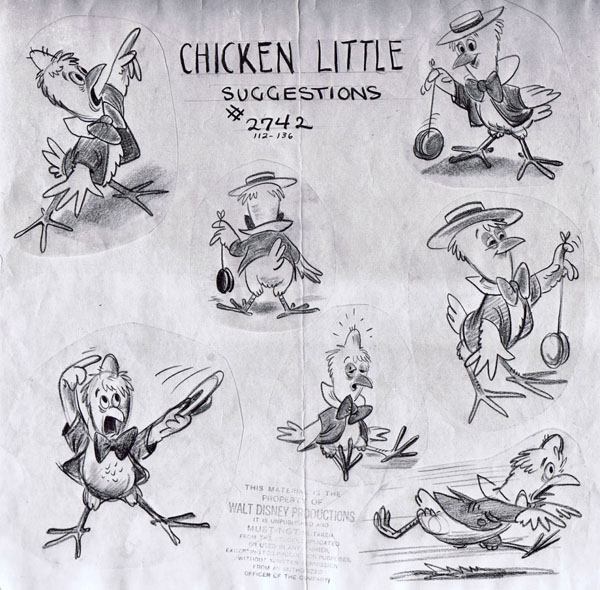
Look, everyone! This sky is falling in this week’s breakdown!
Not to be confused with the Disney CG feature released in 2005, a cartoon “special” of Chicken Little was first animated by the studio in 1943 – much more in line with the original folk tale that originated around the 19th century. But this version of the story, released during the height of World War II, is a contemporary allegory: A simple barnyard community, already under the rule of the presumptuous Cocky Locky, falls prey to the words of a sinister alarmist, Foxy Loxy. His campaign of whispered hearsay and lies influence the not-so-bright Chicken Little to lead his fowl away from the confines of the coop. Their grim downfall is created via rumors about Cocky Locky. Gossiping was a constant problem amongst soldiers during the war. Slogans such as “Loose Lips Might Sink Ships” were emblazoned on government posters to warn against unguarded speech that would aid the enemy.

Frank Graham
Before arriving at Disney’s, director Clyde “Gerry” Geronimi collaborated with a different Walter. He worked with Walter Lantz for about a decade; he animated and co-directed shorts for him at International Film Service and Bray Studios in New York, and moved to the West to work at Lantz’s new Universal outfit as an animator. He served as an animator at Disney’s, until he became a director in the mid-‘30s, with Beach Picnic (1939).
 In Chicken Little, Geronimi casts most of the animators by character—Milt Kahl animates on a majority of the scenes with Chicken Little and the barnyard fowl. Foxy Loxy’s scenes are split between Ward Kimball and Milt Kahl, while Norman Tate supervised the animation on Cocky Locky, and scenes with Goosey Poosey and Ducky Lucky. Ollie Johnston and John Lounsbery are assigned by key sequences; Johnston animates Chicken Little listening to “the voice of doom” and running to warn the community. Lounsbery animates the montage sequence of the barnyard gossiping about Cocky Locky’s supposed derelictions; he is also assigned later sequences of the panicked lot rushing to the cave.
In Chicken Little, Geronimi casts most of the animators by character—Milt Kahl animates on a majority of the scenes with Chicken Little and the barnyard fowl. Foxy Loxy’s scenes are split between Ward Kimball and Milt Kahl, while Norman Tate supervised the animation on Cocky Locky, and scenes with Goosey Poosey and Ducky Lucky. Ollie Johnston and John Lounsbery are assigned by key sequences; Johnston animates Chicken Little listening to “the voice of doom” and running to warn the community. Lounsbery animates the montage sequence of the barnyard gossiping about Cocky Locky’s supposed derelictions; he is also assigned later sequences of the panicked lot rushing to the cave.
In conjunction with the caricatured human behavior in Chicken Little’s animation, there is also some complex acting in the film. Chicken Little’s progression throughout the film is portrayed with a sharp credibility in Milt Kahl’s animation. During the sequence as the excited Chicken Little displays and holds the piece of the sky which struck him on the head, the barnyard commands his attention. After Cocky Locky disproves him, they disperse and leave him alone, disheartened, with a tear in his eye. As Cocky Locky’s reputation wanes, Chicken Little is prompted by “the voice of doom” to take charge as a leader, giving him purpose, while striving for acclaim. However, after Cocky Locky, their former leader, is hit by another piece of the sky, the entire barnyard populace turns to their new diminutive guide, who realizes the gravity of his responsibilities to sustain their protection.
 In the original release of Chicken Little, Foxy Loxy reads how to manipulate his prey from Adolf Hitler’s “Mein Kampf.” In this version presented here, as shown in circulating copies, it was changed to the more generic “Psychology.” No known copy of the original release has surfaced; animator Milt Gray recalled viewing it at a Saturday matinee for children matinee, of all venues, in the early ‘60s, mixed with a random selection of Disney shorts.
In the original release of Chicken Little, Foxy Loxy reads how to manipulate his prey from Adolf Hitler’s “Mein Kampf.” In this version presented here, as shown in circulating copies, it was changed to the more generic “Psychology.” No known copy of the original release has surfaced; animator Milt Gray recalled viewing it at a Saturday matinee for children matinee, of all venues, in the early ‘60s, mixed with a random selection of Disney shorts.
In the draft, the original dialogue is significantly different from the revised changes in the re-issue, including the closing line, which Foxy utters to the narrator: “Oh yeah? That’s how it reads in ’Mein Kampf’!” It’s unclear when these changes in the animation and the soundtrack occurred, though they could’ve been inserted before Frank Graham’s death in 1950.
The draft also indicates the layout artist was Charles Phillipi, a cartoonist for the Los Angeles Examiner before Disney hired him in the summer of 1931. Rusty Jones is the film’s assistant director. The first page of the mimeographed document is shown as a negative image, in order to read the text, instead of displaying a badly faded page.
Enjoy the breakdown video! Be sure to compare the dialogue of the draft and the re-issue version shown here:

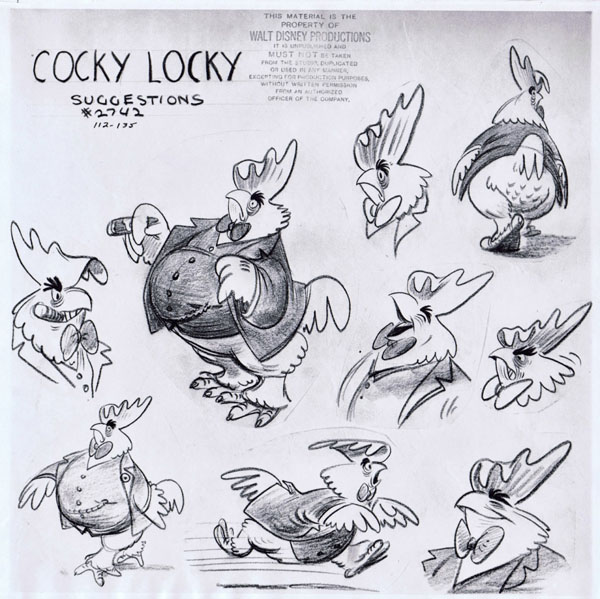
(Thanks to Mark Kausler, Yowp, Frank Young and Michael Barrier for their help.)




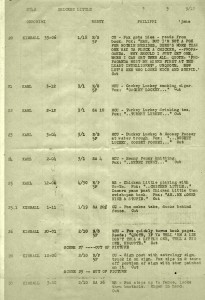


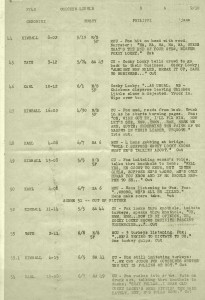

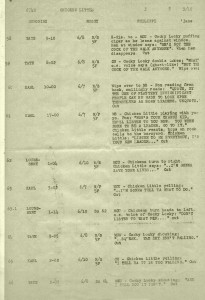


 DEVON BAXTER is a film restoration artist, video editor, and animation researcher/writer currently residing in Pennsylvania. He also hosts a
DEVON BAXTER is a film restoration artist, video editor, and animation researcher/writer currently residing in Pennsylvania. He also hosts a 





















































































I remember watching this on The Wonderful World of Disney back in the 70s. I didn’t know it was a WW2 propaganda short until later. The unhappy (for the birds) ending surprised me at the time. The voice of Cocky Locky was definetly inspired by W.C. Fields
“I remember watching this on The Wonderful World of Disney back in the 70s. I didn’t know it was a WW2 propaganda short until later. The unhappy (for the birds) ending surprised me at the time. The voice of Cocky Locky was definetly inspired by W.C. Fields”
Aside from The Disney Channel often playing this during Donald Duck Presents or somewhere else, I recall a filmstrip version that was played in schools that oddly cut out the final part with Foxy Loxy finishing up his meal in the cave as if they didn’t want to show that final part of the film at all. I never knew why they couldn’t squeeze out a few more frames to show that.
The re-worked last line seems stronger to me than the original. It was fine for its time but it would make the picture horribly dated now. As it is, the story still seems fresh and timely.
This cartoon was presented on “Walt Disney’s Wonderful World of Color” with Ludwig Von Drake narrating.
You can tell this was made during the war as a piece of cautionary propaganda. During peace time, the ending would have been unthinkable, especially for Disney. The comic book version of this cartoon spares the lives of the hapless victims, while an accidental boulder traps Foxy Loxy in his cave.
This is an instance of the time period and the subject matter working together to create a brilliant piece of satire. Thanks for the breakdown–it’s fascinating to know which animators were responsible for the various scenes–in this cartoon, even a lay person who is not as savvy about animation history will recognize some of the names.
I recall a similar Ludwig Von Drake episode (maybe the same one) that featured “Reason & Emotion”, but cut out/dubbed over much of the Hitler/WWII references to make it more contemporary/relevant in the way it was presented 20 years later.
This is a great short, and I’m sure this is the version included on the RARETIES collection from the WALT DISNEY TREASURES series. Frank Graham was one of those memorable voice over talents, but whenever I heard that raspy character that is the fox herein, I do think of the Wolf in various MGM classic Tex Avery-directed titles, and we all know which those are! The RARETIES collection is one of my favorites of the TREASURES volumes because of its array of one shot titles.
That Rarities set is excellent!
“Chicken Little” can also be found on the Treasures set: On the Front Lines.
This is much superior to Disney’s CGI Chicken Little (2005) ….Frank Graham = Disney’s Mel Blanc!
I was wondering how or why did they changed the book from “Mien Kampf” to the generic Psychology, and if Chicken Little was originally animated as a propaganda film to induced the fears and hysteria on people after hearing rumors by others and the outcome of what happened afterwards?
I’d have to go back and listen to it to make sure, but I seem to remember the cartoon’s commentary track on the DVD giving the impression that the change from “Mein Kampf” to a psychology book was made prior to the film’s original release. Am I remembering incorrectly?
Disney WW2 historian extraordinaire David Lesjack has posted this “board” from a 1943 Coronet magazine. (click to enlarge):
Despite what the narrator in the cartoon and the captions on this “board” say, every version of the story I’ve heard has ended with the fox eating them all, just like in the Disney version. It’s almost like, because the Disney staff weren’t able to give this story a happy ending and still get their message across, they had to pretend the story was *supposed* to have a happy ending.
The book actually said “Psychology” in the 1943 release. I have an original still from 1943 that shows it.
That clears things up a lot, for sure! Thank you, Bill!
Sometimes it’s nice to clear up the mystery now and then. The DVD did make it seem like they were going with Mein Kampf but changed it to the generic “Psychology” at the last minute, but there is this one drawing (perhaps a layout sketch) showing Foxy Loxy reading the original book.
https://www.pinterest.com/pin/30891947416571099/
Thanks for sharing that, Bill.
The scenes with the psychology book are seamless, with no telltale signs that they were changed after the fact.
Certainly is. More so than the effort to remove the original Jewish peddler disguise from Three Little Pigs 15 years after the fact. It’s night and day the differences in coloring and backgrounds.
This cartoon is nothing short of EXCELLENT! I love it!
Always loved this short when it came out on the Disney Channel. Amazing they would show it considering the ending. Ironically, later showing cut the line “He’s not the cock of the walk anymore” and some of the scenes of the ducks acting drunk. Apparently, accidental innuendo and alcohol use got greater priority from the censors than implied genocide.
One question about the draft. What does “M.R.” mean on the scenes with no animation? Other drafts have N/A for “no animation”, which makes sense.
That stands for “music room,” named after what began as the conference room with a director and Carl Stalling’s piano. However, credits like this mean the scene was timed to a certain length by the director, in this case, Geronimi, to have no animation.
Actually, it was “Jeff Regan, Investigator” that starred Frank Graham, who had replaced Jack Webb (who left to create “Dragnet”) in the title role.